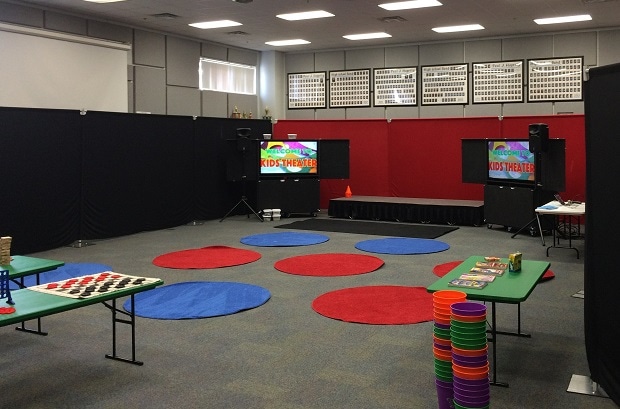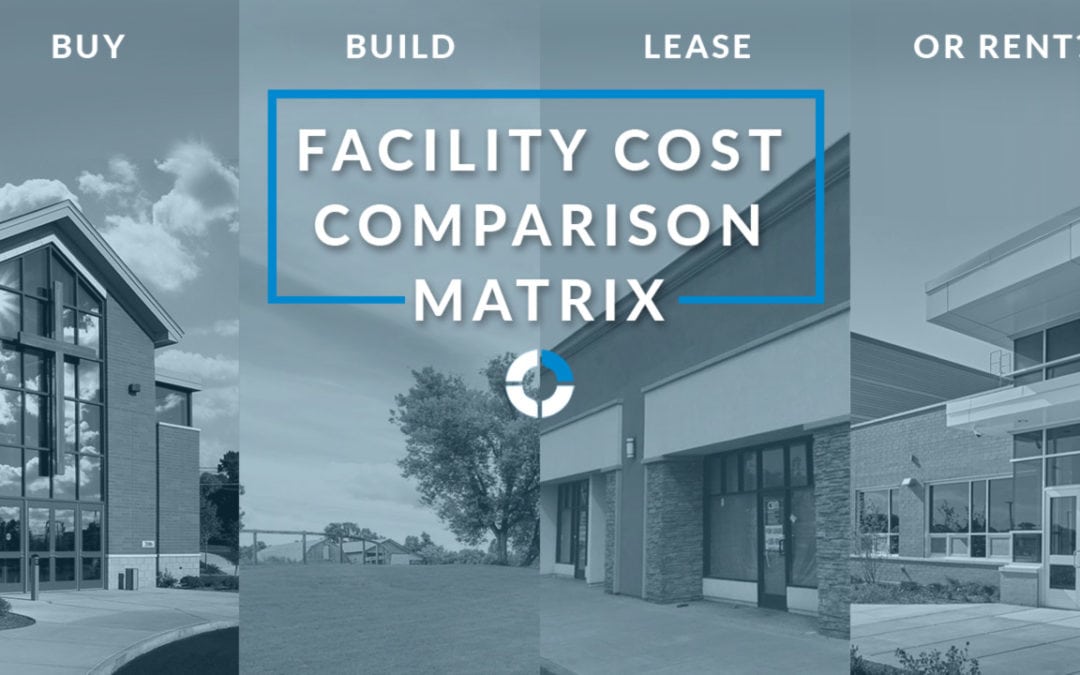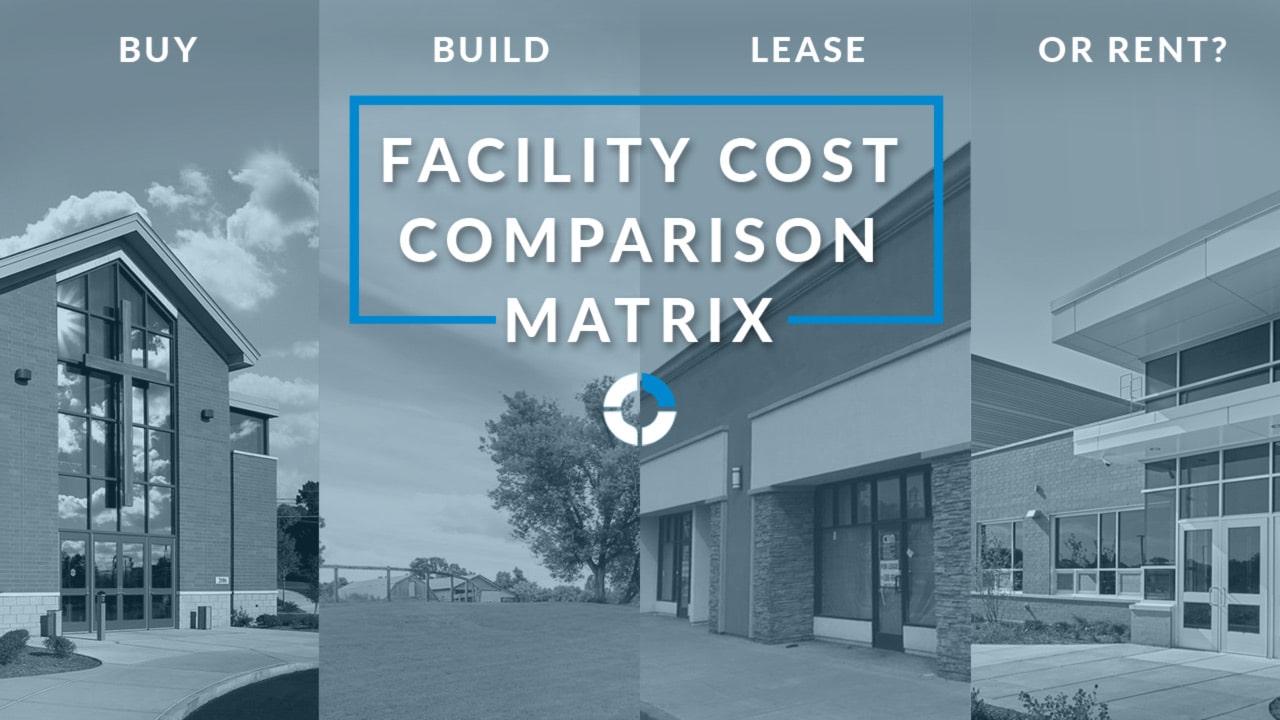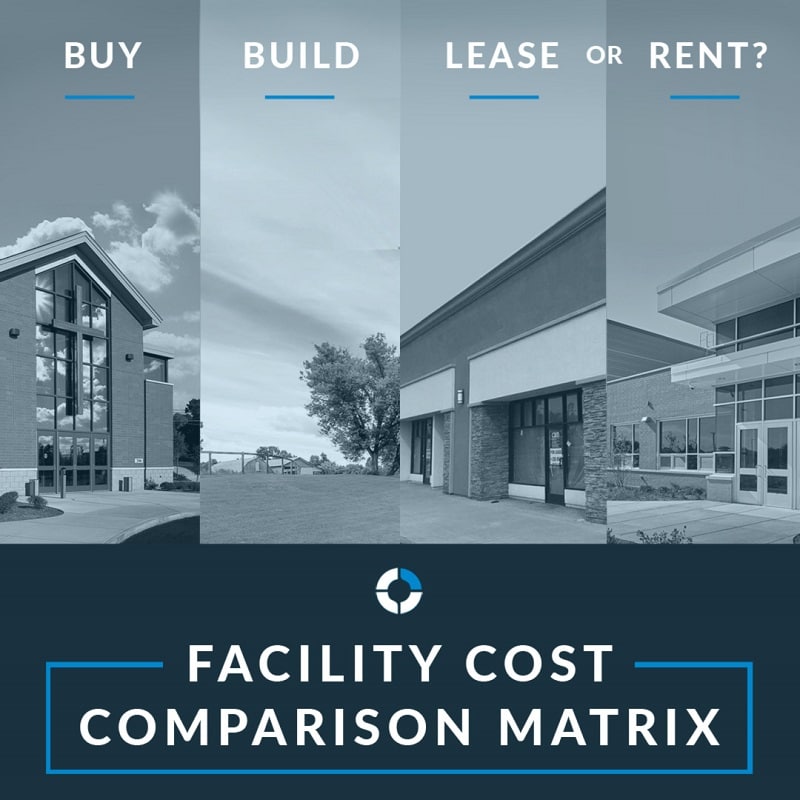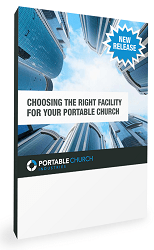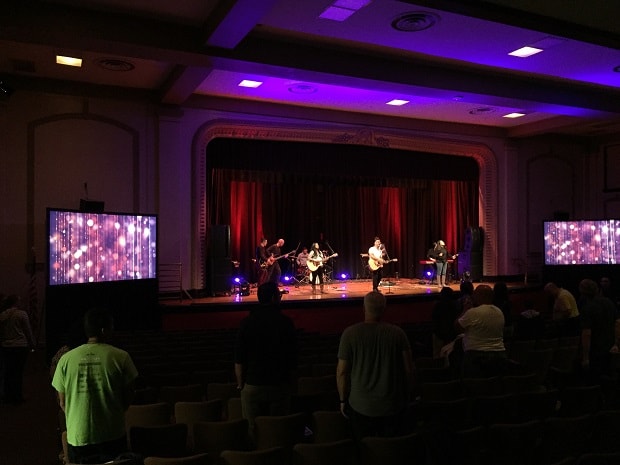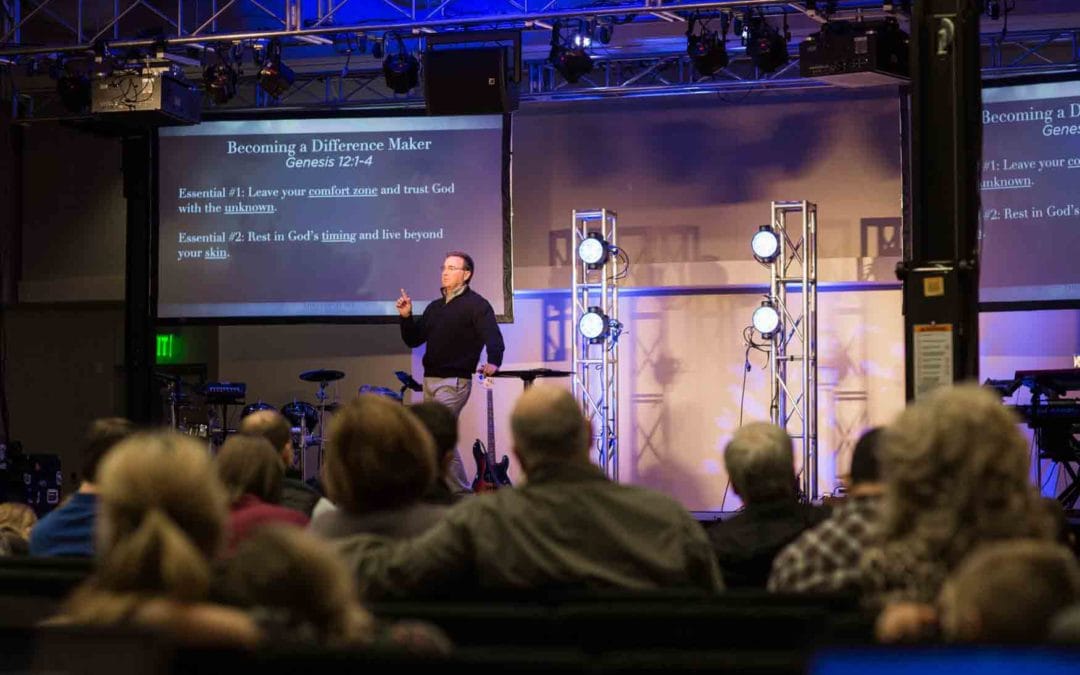
Children's Ministry, Portable Church Systems
“Let the children come to me.”
Children’s ministry is an important focus area for many churches. After all, it is essential for churches to speak into the lives of the little ones.
Did you know that the children’s areas play a crucial factor in determining how dynamic the children’s ministry is at your church? Yes, indeed! The children’s spaces need to be strategically set up to ensure that parents feel happy, kids stay entertained and volunteers work efficiently.
Here are 12 practical tips that can help you ensure that your portable church facility is a fantastic venue for your children’s ministry.
Establishing a secure environment
Ensuring the safety of children needs to be a top priority for any church. Parents must be able to completely trust you with their little ones. Here are some key pointers to make sure that happens:
1. Find a space that can be blocked off from the main meeting areas. This ensures that no unwanted people can walk in.
2. Set up a check-in and check-out system outside the kids’ area. Upon check-in, each child is handed a name tag that identifies both the child and the parent(s). At the end of the service, the child should be handed over to the adult who dropped him/her off. Check-in units give parents the confidence that their children are safe during the service.
3. Protect kids from potential hazards. Electrical outlets and cables that are on the floors or sitting low on the walls should be secured and covered.
4. Get volunteers to monitor security. Volunteers must monitor the entry and exit points to ensure that children don’t wander off and strangers don’t come in. In fact, they should stay alert till all the families have left the building after the service.
5. Have an evacuation plan in place. Emergency procedures need to be created, periodically reviewed, and most importantly, clearly communicated to volunteers and parents.
Setting up wisely
Think about the layout, setup and use of facilities at the venue beforehand. The following tips can help your volunteers function more efficiently:
6.Cater to growth. Your children’s areas should be able to accommodate a sudden increase in the number of kids. Furniture should be easily movable to create additional space, when needed. Be sure to adhere to the recommended square foot area per child.
7. Set up different areas for different ages. The facility should have at least two areas for elementary and preschool kids. If your church meets in a movie theater, your children’s spaces could be spread across the lobby, hallways or in multiple theater rooms.
8. Use the facility’s areas and equipment prudently. Launching in a school often means that you have access to the desks, chairs, projector etc. The big screens in the theater, on the other hand, double up as impactful teaching tools. Some venues might also allow you to use any unused areas/rooms to store equipment during the week.
9. Have a separate restroom for kids. Children should not need to walk a long way to the restroom – especially where they can disrupt the service! A restroom within or near the kids’ areas makes cleaning up after a messy activity or snack easy. A dedicated restroom for kids is also important for security purposes.
Creating a welcoming atmosphere
A welcoming church environment plays a key role in making kids, and their parents, feel right at home. Parents will be hesitant to drop off their kids to an area that looks untidy or dingy. Here are a few things you can do to transform your kids’ areas into a clean and comfortable space:
10. Set up the children’s space well in advance. An untidy room will tell parents that you are disorganized and not prepared to take care of their children. Set up the areas to look neat and amazing, and make a great first impression. Keep in mind that kids who are in school all week, will not see sitting in a similar classroom setup over the weekend as fun.
11. Use banners and signs to make your church easily navigable. Clearly mark the check-in station outside the children’s area with a prominent banner. Make sure the signs are facing the entrance, so that they are not missed when families enter your portable church. In fact, when an attendee is standing at the first sign with directions, he/she should be able to clearly see the next sign. When he/she arrives at that second sign, the third should be clearly visible, and so on.
12. Use bright colors and graphic wall panels. Dingy walls or inappropriate posters are a big no-no! Colorful signs, props and toys can help change a space into a clean, comfortable and exciting environment. Scuba walls and graphic wall panels are great for hiding anything unsightly, and transforming the area into an awesome space!


You want to create an environment that has kids wanting to come back each week. All these tips can help you transform your portable church venue into a creative and secure environment for children!
The Portable Church teams have helped tons of churches launch and set up in all kinds of unique, portable venues. If you want help in finding and moving into the right facility for your church, call us at 800.939.7722 today, and we’ll help you find the perfect venue to launch in.


Church Planting
With over 156 million unchurched people in America alone, church plants are the need of the hour. However, church planting can be a difficult road – one that doesn’t always end with success. In fact, statistics suggest that 30-40% of churches are not likely to survive past the first few years.

How can you prevent your new church from meeting a similar fate? Avoiding these seven common church planting mistakes is a good place to start:
1. Launching too soon
Launching prematurely is a common and costly mistake that many church planters end up making. The zeal to fulfill the Great Commission can often lead planters to hasten the process of church planting. However, this invariably means skipping or rushing through many necessary pre-launch tasks, such as administrative work, finding the right venue, ordering equipment and training teams.
Planters and authors Jim Griffith and Bill Easum say that a premature launch places the new church in a “crisis mode” from day one and quickly drains money and morale. In fact, many experienced planters suggest taking nine months to launch a church. Make sure you are not rushing to launch your new church.
2. Relying too much on the church planter
Church planting is certainly not a solitary effort. However, there’s a popular and often-glorified image of “the church planter.” After all, successful church plants are mostly led by dedicated teams, not individual church planters. The idea of a lone church planter can be a dangerous one.
You need the support of a team, including able administrators, creative minds and marketing experts, to successfully launch a church. Whether your team is made up of paid staff or volunteers, do remember to clearly communicate the purpose of the team’s existence from the word go! Is your church plant relying on one personality or an equipped team?
3. Resisting other church leaders
Many new churches hesitate to let other church pastors and leaders get involved in the planting process. In doing so, they often miss out on much-needed insights and encouragement.
Tim Keller has some good advice: “Collaborate with your fellow planters and pastors; don’t compete with them.” It is a good idea to receive the wisdom and counsel of others ahead of time. Why make the same mistakes that someone else has already made?
4. Shying away from money talk
Many churches avoid talking about finances out of the fear of being misinterpreted as “always talking about money.” And, when they finally do talk about money – it’s often too late!
Well, it takes money to do ministry – just like everything else in the world! Brad Leeper from Generis emphasizes the need for church planters to talk about money and stewardship like any other regular conversation.
New churches need to come up with coherent plans about sustaining their ministry in the early years. So, don’t hesitate to talk about money with your church and supporters. How can you expect people to give money to your church, if you don’t even talk about it?
5. Not focusing on evangelism after the launch
The BIG launch is a huge deal for all church planters! Most churches put all their efforts into reaching out to the community and inviting people for the launch. However, after the launch, many new churches tend to settle down to offer discipleship and pastoral care to those already in the fellowship.
Offering mentorship and pastoral care without a plan to continuously reach new people can lead a church to stagnation. Therefore, it is key that your church has a strategic plan for evangelism that extends beyond the launch date. Does your church plant continue to focus on evangelism post the launch?
6. Formalizing leadership too soon
Many church plants take the step to institute official leadership posts soon after the launch. Sounding official is great, but it can actually prove to be detrimental for a new church.
Jim Griffith and Bill Easum stress the difference between being organized and being official. While the former is essential, the latter should be deferred until church planters are able to identify and assess leaders who have proven themselves in the fellowship. You might find that many who are involved in the early stages of the launch move on in the course of the church’s early growth.
This process of identifying, assessing, releasing and equipping leaders is a complicated one and can take a few years. Are you rushing to formalize the leadership at your new church plant?
7. Not planning beyond the weekend service
Getting people to show up on a Sunday morning (in person or online) is often the focal point for many churches. However, that’s far from enough! It’s equally important to have a solid plan to plug people into the church community and help them grow in their walk with God. It takes a lot more than weekend services to do that!
Your church needs to come up with a strategic and coherent plan for the rest of the week – Bible study, small groups, mid-week ministry – because there’s a lot more to think about! Is your church plan solely focused on the weekend services?
What are some of the other mistakes that church planters need to watch out for? Leave a comment below and share your insights with us.
At Portable Church, we understand that no two church plants are the same. Keeping this in mind, our experts design custom solutions to help church planters like you launch strong! So, if you are planning to start a church, we can help make the process easier for you! Give us a call today at 800.939.7722 and we’ll help you launch smoothly.
That’s not all! We also have amazing free resources for church planters like you. Get our Church Plant Timeline for a check list of things to do as you plan to launch your church. Download your free copy today!

Church Launch, Facility, Multisite
The rise of the multisite church is not a fad. In fact, it seems to keep growing over the years. However, this doesn’t mean that multisite churches don’t come with their own set of hurdles.
Are you are looking to launch a multisite church? Well, we’re here to make sure that you’re well-prepared to take on any roadblocks that come your way!
Here are the eight biggest challenges that multisite churches face. And, practical solutions to help you overcome them!
1. Dealing with an identity crisis
While church plants need to maintain the original church’s DNA, each campus is bound to attract a different crowd, have some variation in style of worship and build its own distinct culture. The big question is – how do you strike a balance?
It’s crucial that you decide on your methods early on! Here are some things to think about: Will the new campuses make every decision after asking the mother ship? Will each campus alter its identity to reach the community it is in? Will the satellite venues stream weekend services from the main campus. Or, will different campus pastors deliver different messages each week?
Once you have answered these questions, you will have a basic church structure in place. Zeroing in on the structure of the new campus, early in the game, is absolutely key. The next step is to communicate that plan to your entire team – well before the launch! This gives them time to soak it all in, set the right expectations and prepare themselves for what lies ahead.
2. Appointing the right leaders
Finding the right leadership is one of the most crucial – and perhaps one of the hardest – aspects of launching any new church. Most multisite churches grapple with the question – where are the leaders going to come from?
Should you appoint leaders from outside or split your current leadership?
Jim Tomberlin, founder and senior strategist of MultiSite Solutions, offers valuable suggestions about recruiting new leaders. He suggests that it is best to first identify people within your team, or even your congregation, who embody your church’s DNA, have leadership qualities and would be ready for a new challenge.
No luck at home? “The next best place to look is within the network of your own staff team,” says Jim. They are bound to know many people serving in other churches. Ask them to pass the word around. Remember that any leader you bring in from outside must be allowed to train and acclimatize for a year – before the big launch.
3. Ensuring that new leaders share your church’s vision
You might have finally found the right people for the leadership team – but the battle is only half won! How do you make sure that the larger vision of the church doesn’t get lost?
Communicate, communicate, communicate!
As your church plans for the new launch, each ministry team has the tendency to plan in isolation for their specific ministry. This way, it’s easy to overlook the overall vision of your church. Therefore, it is important for the leaders of each team to meet regularly to interact and brainstorm. This will make sure that everyone is on the same page, and will also avoid duplication of efforts.
Do remember to set up channels for regular communication and accountability from the start. Cast the vision. Set the boundaries. Keep talking!
4. Finding the right staff and volunteers
Finding the right staff for a single church venue is hard enough (especially post Covid-19). A new church needs a motivated group of volunteers and staff for a seamless, day-to-day running of church operations. And, building a driven and well-trained team of volunteers takes time. Many multisite churches face the challenge of finding equally eager volunteers for two or more campuses.
Will Vanderbloemen, pastor, and founder and CEO of The Vanderbloemen Search Group, offers some interesting perspective about finding the right talent. “The best recruiting churches I know have a white hot vision for people far from God. When they recruit staff, they point to the eternal impact that their employment will bring.”
Are you ready to recruit volunteers and staff with the same vision casting that you recruit people into the Kingdom with?
5. Making sure you have adequate finances
Funding! That’s one of the biggest challenges many new churches face. What happens if a new campuses don’t become financially sustainable, and how does one jump over the funding hurdle, and land on both feet?
Once again, the key is to ask the right questions well before the launch. How much money is the parent church prepared to invest in the startup church? Will each campus have its own budget? Or, will it be a case of many venues, one budget? How will the money be dispersed? How will the plant be accountable to the main church?
As one of the pioneers of the multisite church in US and Canada, Rich Birch is full of valuable insights for those looking to multiply their campuses. He says, “A purposeful timeline gives you more opportunity to build up the financial resources needed to launch well. Use the time to work with donors to build up the financial structure needed for a strong launch!”
6. Finding the perfect location
Location is key! Where you start a church will determine how you interact and engage the local community.
The venue that you zero down on needs to complement the vision of your church. If you want to reach out to the youth, for example, launching in a casual space such as a movie theater or a restaurant would be a good idea.
Make sure that you don’t rush into finding a venue. As Rich Birch says, “You don’t want to negotiate a location under time pressure.” You need to consider costs, accessibility, layout, facilities, equipment requirements and lots more! In fact, here are seven tips to help you land that perfect venue.
7. Delivering a similar experience across all venues
Pushing for consistency can be a pain point for multisite campuses. This is especially true when attendees expect a similar experience as the main church.
It is impossible for your new campus to be a replica of the parent church. It can, however, definitely communicate an identifiable experience. If your church starts with the sermon and ends with praise and worship, consider keeping the same format across all your campuses. Or, if weekend services typically end with free coffee, try and retain that too.
Strive to offer an identifiable, not an identical, experience.
8. Leveraging technology
A great service experience has much to do with good technology and equipment. When launching, make sure that you have at least one technical expert on your team, to take care of your audio, video and lighting needs. That’s not all, your technology leader needs to be a team player – he/she is going to need volunteer support!
We can’t stress the need for choosing the right equipment for your specific needs. The best equipment doesn’t necessarily mean the most expensive one! So, don’t waste money on features that you might never use.
You must also think about the people handling the equipment – will they be amateur volunteers or tech-savvy pros? You don’t want the equipment to overwhelm your team, do you? At the same time, you don’t want poor quality stuff that needs constant fixing!
At Portable Church, our experts have helped many churches launch new campuses. We start right from a consultation that helps us understand your custom needs, culture and vision. Once our custom-built Portable Church solution gets a green light from you – you can sit back and relax!
We’ll help you launch and set up in the right location, with the right equipment.
Read more about how we serve multisite churches.
Give us a call today at 800.939.7722 and we’ll help you launch strong!

Facility

Guest blog post by Tim Cool.
To be or not to be…is no longer the question. For many churches, the burning question is what to do with facilities and do we even need to own a facility. This used to be a question that only church planters were asking. When you are first starting out, the common question is how do we “house” our church?
Do we rent a school?
Do we rent a theater?
Do we find a store front?
What about using another church on an off night?
Given a number of factors, these conversations are no longer limited to church planters but are being asked in a whole host of church settings including established churches looking to get out from under a deteriorating facility that they cannot afford, to churches needing to re-invent themselves. I have been involved in the planning, development and maintaining of church facilities and until recently, this topic was almost never discussed by churches that were more than 2-3 years old.
You may be saying “Duh, Tim…We knew that.” Or this may be foreign territory for you…so let’s take a little time to explore as well as provide a very practical tool for your own evaluation.
To get started, let’s look at some trends and realities:
- For most churches, the cost of owning a facility is the second or third largest expenditure in their budget…usually second to personnel but ahead of dollars actually spent on ministry.
- In most regions of the country, as of the writing of this post, we are seeing significant increases in construction costs.
- In many cities and towns, there are still a large amount of empty church buildings that were vacated as part of the aftermath of the Great Recession.
- The life cycle cost of owning a building during a typical 40-year period of time will be about 80% of the total cost of ownership…it takes a great deal to own a building.
- In addition, if you own a building, then you…your church…has been tasked to be a steward of the facility entrusted to you by God. That is no small responsibility. In fact, in order to keep up with the natural rate of physical deterioration and be prepared for the inevitable life cycle costs, you need to set aside $1-3.00/Square Foot EVERY YEAR. So if you have a 50,000 SF, you need to set aside $50,000 – $150,000 annually.
- Things change…if you do not believe this, please stop reading here. Here are some examples:
- Your church goes through a period of expansive growth or decline…how does your facility flex with those trends?
- Culture around us changes…do our facilities also morph?
- Demographics change…not just race and language, but also age and needs associated with those changes.
- Ministry means and methods change. Are any of you doing “church” exactly like you did 20 years ago? I am a firm believer that the Gospel NEVER changes…but our means and methods must change. How many of your churches use Gregorian Chant? That was mainstream at one time. Winston Churchill said “We shape our buildings, thereafter they shape us.” If you have a building that is more than 20 years old (maybe even less), that space may actually be telling you how to do ministry.
- There is an alarming number of aging church facilities across the country that have declining congregations and deteriorating facilities. Church mergers are on an increase…which I think is really smart. But what about the old buildings. Is buying an old church building right for your congregation? Consider THIS first.
- Church building are hard to sell. As a rule, if your church is not in a commercial setting or prime for re-development, it will likely take 2-3 years to sell and you are most likely going to only net about 50 cents on the dollar of the appraised value.
How do we address these issues? How do we set up our congregation for long term impact and engagement?
I am not going to advocate one option over another…but what I do want us to do is to consider the options. The first and only option should not be to buy land and build a building. The other deeply ingrained paradigm has been that once you own a building, that is it…that is where your church meets forever.
End of story.
Again, I am not saying that is wrong…but we need to stretch our thinking. Ask WHAT IF.
We have developed a tool to assist churches to vet out some of these options. This is not the end-all and 100% inclusive evaluation tool, but it is a tremendous resource to do some initial side-by-side comparison of the options.
If you click HERE you can download this tool.
Now, let me walk you through how to best utilizing the tool and some of the method to our madness:
First, we make the premise that there are 4 basic options (with a multitude of subsets):

- Rent a school
- Lease a commercial/retail building
- Buy a building
- Build a building
We then break costs down into 3 sections:
- Operational Costs
Sticks and Bricks- FFE/AVL (Furniture, fixtures, equipment and audio, video, lighting)
- Lease Agreement Considerations
There are some formulas built in to the spreadsheet such as:
- Cost of TI (Tenant Improvement) for the purchase of a building – we used $100/SF
- Cost of new construction – we used $200/SF
- Operational costs
- Capital reserve costs
Everything else need to be added based on information gathered in your local context.
Again, this is not the only evaluation tool you should use. The old adage in real estate is “Location, Location, Location.” That also needs to be factored into your comparison matrix. Is the location in the right part of the community? Will there be visibility and signage opportunities? Is it properly zoned? Is there ample parking, etc.
To round out this thought, you also need to give serious attention to any leased (not rented…there is difference…renting is usually short term and leasing is long term) facilities or purchased facilities you need to consider:
- If purchasing, is there deferred maintenance you are also inheriting?
- If you plan on more than 300 seats in worship, does the facility have a fire sprinkler system?
- Is the power adequate to support your AVL systems?
- How old is the HVAC system and is it adequate to cool an assembly occupancy?
- What is the condition of the roof?
- Are there enough restrooms?
OK…that probably has your head spinning….which is good. You MUST consider all of the above before you make a serious financial decision. Do not take this lightly. Do your due diligence. Consider all the options. Seek wise counsel. Pray continuously.
ONWARD!
Tim Cool

Download your copy of this evaluation tool:
Tim Cool is founder of Cool Solutions Group, and has assisted nearly 500 churches, (equating to over 4 Million Sq. Ft.) throughout the United States with their facility needs. He has collaborated with churches in the areas of facility needs analysis, design coordination, pre-construction and construction management as well as life cycle planning/facility management. Cool Solutions Group is also the developer of eSPACE Facility Management software products including Event Scheduler, Event Registration, Work Order Management, Life Cycle Calculator and HVAC integration.
Tim is also the author of three books, Why Church Buildings Matter: The Story of Your Space, Church Locality (co-authored with Jim Tomberlin) and Plan 4 It: The 4 Essential Master Plans For Every Church as well as a church Facility Management manual entitled “Intentional Church Series: Facility Stewardship”.
Tim lives in Charlotte, North Carolina with his wife of 34 years, Lisa, and supports his triplet college students.
Blog post originally shared in October 2018.

Church Launch, Church Planting, Mobile Churches, Portability, Portable Church Systems
At PCI our belief is that portability for churches is not going away any time soon. In fact, portability is one of the most important strategies for new churches, multisite churches, and even existing churches. Pastor Carey Nieuwhof said it this way, “Portable church should be a permanent part of the future” and we completely agree. It is not a “temporary solution” until your church finds a building, rather it is a tool to help your church be all that it is called to be.

With that said, we know a lot of pastors have questions about portability and about the pros and cons of it. That is why we wrote this blog, to help address some of the FAQ’s we hear. So here it is, 10 reasons why we think portability is the way to go.
1. Reduce costs
The major advantage of setting up your church in a portable venue is the cost factor. No ridiculously high construction or mortgage costs to deal with. No roof and air-conditioning repairs to worry about. And, no monthly cleaning and security services to shell out money for!
Launching in a temporary facility lets your church make full use of the space without breaking your bank! The only cost you really have to bother about is the monthly rent check.
2. Flexibility
A permanent church building may not be eternal, but it’s certainly long-term! Portability, on the other hand, lets your church enjoy unparalleled flexibility. For example, you might find that you need more seating space to accommodate adults. Or, that you no longer require multiple children’s areas.
Well, here’s the good news – a portable, flexible church means that you can upsize or downsize to suit your needs, anytime!
3. Channel more money for ministry
Less money spent on your building = more money for ministry! Isn’t that a holy equation?
Don’t let the cost of a building choke your church. A mobile church can operate on a fraction of the income needed for a permanent facility. The money saved can then be channeled towards various mission trips, outreach programs and ministry efforts. After all, buildings don’t grow your church, effective ministry does!
4. Welcome the unchurched
Do you know how many unchurched people are in your community right now? And did you know that an increasing majority of this population is wary of the traditional church setting? That’s where mobile churches come in!
Churches in casual, everyday spaces like a school, theater, bowling alley, and even a pizza parlor are way more inviting and welcoming than stained-glass windows and pews. In other words, portable churches offer a huge advantage in equipping you to fulfill the Great Commission!
5. Foster better engagement with community
Moving your church into everyday spaces like a casino or a movie theater, compels you to break the “holy huddle” and engage the community. Moreover, launching in community spaces helps your church “go to the people” instead of asking them to “come to church.”
That’s exactly why the Rolling Hills Baptist Church in Georgia sold their 20-acre campus and moved to a movie theater – to be better embedded in the community.
Is your church looking to make an impact outside of its four walls?
6. Shape church identity
We have heard it a million times – The church is not the building. The church is the people. However, this fundamental fact is often forgotten by church folks.
What does identity have to do with a church “with wheels” and ready to go, go, go? A lot, actually! A temporary location for your church means that people cannot identify the church with a building. A mobile church has to put the people first.
Do you want a building to define your church? That’s a question this dynamic model solves.
7. Keep vision independent of the building
Why should the vision of your church be limited to what the church building can, and cannot, accommodate? Unfortunately, the building often guides the vision of the church. Worse still, the building sometimes becomes the vision of the church.
Is your church focused on the building upkeep rather than on outreach?
8. Encourage thriving relationships
A mobile church is based on relationships. It is not centered around a venue. People who attend a portable church do so because of its mission, and their relationships with other members.
A portable church fosters a better sense of community within the church. A thriving community culture is a sign of a healthy church, isn’t it?
9. Mobilize volunteers
One of the lifelines of a church on wheels is a team of dedicated volunteers, who set up and tear down church equipment every week. People are brought together as they serve alongside, and a healthy core team of contributors emerges.
Pastor, you know that every church needs a core team to move forward. Launching in a temporary facility can be the ideal space to build this much-needed core. After all, isn’t mobilizing and building people crucial for the growth of any church?
10. Unleash creativity
Move your church into a zoo or fire station, and watch those creative juices flow! A church that is not tied down to a specific venue offers endless opportunities for experimentation.
For example, transforming a theater into a fun and safe space for kids, or setting up a stage in a bowling alley can really stir up your creativity! Creativity is a reflection of God’s plan. So, is there a better candidate to display this creativity than the church? Probably not!

Are you looking to launch a church? A decision to move into a unique, church on wheels venue versus a permanent tied-down building might be the best one you take today!
We have been helping churches successfully launch in all kinds of venues for the last few decades. Give us a call today at 800.939.7722 and we’ll help you find the perfect church location for your weekend services!
In the meantime, Download our FREE E-book today for all the tips you need to choose the right facility for your church! Find the Right Venue For My Portable Church

Children's Ministry
Kids can’t wait to get to school on Sundays. Yes, that’s right! An increasing number of portable churches are launching in public venues including school gyms and classrooms. And, kids are just loving the fun and welcoming environment that these churches are creating!
Do you want to engage children in new and creative ways at your church? The freedom to experiment is one of the biggest advantages that portable churches enjoy! Here’s some inspiration from real churches that have transformed regular schools into exciting and engaging spaces for kids.
Cooking up a lesson in faith
The erstwhile ordinary cafeteria of Topsail Middle School now doubles up as a colorful environment for the Reno Kids – the children’s ministry at Renovation Church, NC. Here, the youngest churchgoers crawl and play together in a comfortable space where loving volunteers keep them occupied with coloring, songs and storytelling.
That’s not all! Camp Renovate, for elementary kids, successfully reflects the adventure and thrill of God’s word for that age group. Here, leaders and kids break off into small groups that meet in classroom-sized tents. Creativity at its best, isn’t it?
Meeting in a box
The Seaside Community Church of Huntington Beach, CA, has indeed unleashed its creative juices! This church puts a storage container on the property of Sowers Middle School to fantastic use.
On Sundays, this 40-foot shipping container is set up with couches and bookcases. In addition, some AstroTurf is rolled out under a big canopy in the front to create a casual and fun spot for teens to gather and learn about God. What’s not to love?
Keeping parents happy
Ensuring the safety and security of kids is one of the primary responsibilities of any church. And Faithbridge Church, TX, was able to assure parents that their kids are safe and well-cared for during their weekend services.
Faithbridge meets at an elementary school in Woodlands. The experts at Portable Church designed a solution that enables Faithbridge to use portable check-in units where parents print name and security tags for their children. Moreover, these custom units are integrated with a central database, further ensuring a secure environment for the kids.
Action Church in Oviedo, FL, is another portable church that meets at a high school. This church has successfully established systems and processes to ensure a comfortable and inviting experience for children from the word go! Parents and kids are welcomed at the curbside and a volunteer escorts each child to the classroom after check-in. Moreover, the kids’ areas are set up independently from the main worship area as an added safety measure.
Both Faithbridge and Action Church have transformed school spaces into safe, comfortable and engaging areas for their children’s ministries. Isn’t that what every parent wants?

Each of these churches (along with hundreds more) partnered with Portable Church Industries to successfully transform the different schools to meet their specific needs. In fact, our experts have helped hundreds of churches move into movie theaters, community centers, restaurants and more (even a casino!).
If you are looking to launch your church in a public space, we can take care of all the groundwork for you! Give us a call at 800.939.7722 today, and we’ll help you find the perfect venue to launch in.

Church Planting
If you are called to plant a church, we understand that is no small task. Which is why we are here to help. Here is a lit of 10 practical tips for church planters. Check out these words of wisdom – right from the experts:
1. Put together a launch team, rather than a core group:
Planting a church is by no means a one-man job. You need the support of a team that brings a range of gifts to the table. From effective administrators and implementers to creative minds and marketing experts – you need them all. Ideally, you want a high-commitment and flexible launch team, not a core group with a potential sense of entitlement.
Dr. Tom Nebel says that gathering a launch team, instead of a core group is key. By definition, launch teams are task-oriented, and once the task is completed (i.e. the church is successfully planted) you are free to reassign them or they are free to leave. On the other hand, a core group implies a close-knit team at the center of all decision-making activities, and fundamental to the execution of your church’s vision. A core group doesn’t disband easily post the launch.
2. Collaborate, don’t compete with fellow pastors:
Pastor and church planter, Ed Stetzer stresses the need for church planters and plants to form healthy relationships with other churches. Established churches and experienced pastors can offer valuable insights to church planters like you (and vice versa is also important).
Moreover, such relationships prevent the emergence of a myopic approach to ministry in a new church plant. Collaborating with other churches will remind you that you are part of both a local and global mission.
3. Empower others from the start:
In Global Church Planting: Biblical Principles and Best Practices for Multiplication, authors Craig Ott and Gene Wilson emphasize the need to instill a spirit of empowerment earlier on in a new church plant. Mobilization of the whole church for ministry allows a church to keep growing and reaching people for Christ. The church planter’s role then shifts from being motor and model to mobilizer and mentor.
Therefore, remember to focus on nurturing, equipping and developing lay leaders. As lead pastor of Next Level Church, Matt Keller says, “Communicate not just the How and What of your church, but also the Why behind the What.”
4. Create an annual funding plan, not just a budget:
More often than not, funding remains a challenging area for church planters. Therefore, it is crucial to develop a funding plan, with all the information related to your church’s financial needs.
Casey Graham from The Rocket Company urges church planters to go beyond creating a budget to making a funding plan that includes following up with donors, emphasizing digital giving, discipling high-capacity givers and more.
5. Normalize a culture of generosity and money conversation:
Many pastors avoid the money talk either out of fear or not knowing how to lead in the area of giving. Brad Leeper from Generis stresses the need for church planters to talk about money and stewardship like any other regular conversation. More importantly, you need to encourage your core teams to be generous. “Generosity may be the best evangelism strategy that you possess,” adds Leeper.
Therefore, don’t hesitate to talk about money with your church. Remember that people will not give you money, unless you ask.
6. Sort out your paperwork soon:
Planting a church takes vision and calling, but also requires a fair share of administration. We can’t stress it enough – don’t wait to get your church documents in order. Once you have decided to plant a new church, there are several important affairs, such as preparing your church constitution and statement of faith, which should be taken care of from the start.
In addition, you have incorporation, tax-exempt status, bank accounts, insurance coverages and other legalities to think of, too. So, listen to Joel Kurz, lead pastor of The Garden Church, and get your documents organized as soon as you can!
PS. We put together a Church Plant Timeline for exactly this reason.
7. Welcome diversity:
Plant your church for all people. Make it a point to reach out to people across ethnic and economic lines. According to Mark DeYmaz, founding pastor of the Mosaic Church, “Whether you are in a larger or smaller congregational context, know that the pursuit of the multi-ethnic vision matters to God and to your community.”
Diversity will help carry the message and influence of your church much farther and wider.
8. Be responsive to community:
Each city, community and group of people is unique. Therefore, it is crucial for you to identify the pulse of the community where you want to plant.
Make a special effort to get to know the culture, traditions and needs of the people. This will help you develop outreach programs that specifically cater to that particular community. Ron Edmondson says that it is important to personally get involved and serve in the community where you want to plant a church. In his words, “To be a Kingdom-building pastor, you MUST be a community-building pastor.”
9. Be ready to adapt:
Mark Reynolds from Redeemer City to City has one advice for church planters: “sustain high-learning agility.” Sometimes church planters can get taken up with a specific ministry model. This means that they set themselves up for discouragement if it does not work.
Therefore, remind yourself to learn from any mistakes that you make, and constantly adapt to the surrounding conditions. Mark says that having an experienced coach can help church planters and plants adapt as well as grow.
Further, church planters need to be patient with other leaders and teammates who might disagree with their vision and direction for the church. Founding pastor at River City Community Church, Daniel Hill’s advice to church planters is to be flexible with how people may grapple with their vision.
10. Don’t forget to invest in your family and marriage:
This one may be the most important, because church planting is not only stressful for the church planter, but also his/her family. Often church planters sideline their spouses and kids as they fully invest themselves in serving the Kingdom.
Michael Lukaszewski, founder and CEO of Church Fuel warns about how easily the desire to spread the Gospel and do ministry work can draw you away from ministering to your spouse and family.
Your family members can be your biggest support system as you take on the BIG responsibility of planting a church. Therefore, involve them in what you are building for the Kingdom.
 So, are you ready to start a church?
So, are you ready to start a church?
The experts at Portable Church have been helping church planters successfully launch in all kinds of venues for the last few decades. Reach out or give us a call today at 800.939.7722, and we’ll help you move into the perfect church location for your weekend services.
We have also put together some of the most important things to keep in mind as you launch your church in a FREE e-book for you. Download the 5 Essential Ideas for Church Planters today!

PCI Church Plants
We originally created this infographic a few years back. However, post-Covid… these things are more true than ever. As you make your plans… keep these time tested insights in your mind!
I am grateful for the team at LifeWay Research and
NewChurches for
The State of Church Planting in the US report they released. At Portable Church Industries, we work with hundreds of church planters each year to assist them in planning, preparing, and launching new churches in rented spaces. We see and hear a lot and I was curious to see if NewChurches would recognize the same trends and critical success factors as we have. They did. It is surprising to see these stand the test of time especially during and coming out of Covid.
The Kingdom of Christ is most impacted by effective and frequent launching of new churches. The NewChurches Report found what we find: at church plants, you are more likely to find non-believers, new residents of the community, and have greater leadership participation.
In addition, having a highly public presence for the new church plant affects attendance, discipleship, leadership development, and financial sustainability. Interestingly, across the board, churches that launched in schools (a very highly public place) consistently had greater average worship attendance than churches launching elsewhere.
Yet, establishing a thriving church in a rented space has its unique challenges. Partnering with a company that has expertise in maximizing the worship, children’s and visitor experience increases the likelihood of the church’s success, financial sustainability, and long-term effectiveness. At Portable Church Industries we celebrate the recent surge in church planting and stand ready to assist church plants launch strong in very visible public places like schools, movie theaters, community centers, and much more.
We hope you enjoy this resource we’ve created from some of the great information found in
The State of Church Planting in the U.S. 2015 Report. To access the full report, become a member at
NewChurches.com!

Church Planting, Helpful References, Portability
Peter Wagner has famously said that church planting is the “single most effective evangelistic methodology under heaven.” However, the journey of planting a new church is far from an easy one, which is why you need church planting resources!
Anxiety regarding finances, stress about leadership and uncertainty about success are some of the challenges that church planters face. Nevertheless, the right support can help ease the tension and make the journey worthwhile. Well, what better way to seek guidance than to learn from those who have walked this journey before? We have now compiled a list of 15 essential church planting resources by some of the best in the field. Let’s take a look:
Online resources
We need more churches! That is why many leaders have set out to equip and empower church planters by providing easily accessible online resources. In this following section, we have put together a few online resources that can bless your journey as a church planter.
1. StartCHURCH
As the name suggests, startCHURCH provides all the information you need to kick-start a church. Here, you will find a list of services, products and conferences to help you with all the essentials. From practical help and tools for establishing a board to sorting out your tax – startCHURCH covers it all! Explore the website for more information.
2. NewChurches.com
This online hub, by Ed Stetzer and Daniel Im, is buzzing with podcasts, courses, event listings and other resources related to church multiplication. With a continuous flow of support from experts such as Todd Adkins and Shawn Lovejoy, this website is bound to offer you key insights regarding church planting. Take a look at NewChurches.com here.
3. Christianity Today’s Church Planting Resource Roundup
Check out Ed Stetzer’s compilation of blog posts, including 3 Pieces of Advice from a Church Planter to Church Planters and 5 Reasons Established Churches Should Plant Churches. These rich resources will certainly help you take the right steps in the course of your church planting journey. Explore Ed Stetzer’s curated list of resources here.
4. Ministry Grid
If you’re looking for training by ministry experts, Ministry Grid is your online destination. Here, you will find over 3,000 exclusive training videos that cover every aspect of ministry.
You can either sign up for the individual plan – perfect for an individual leader; church plan – ideal for a church of any size; or a ministry plan – best suited for building a particular ministry area. Check out Ministry Grid and see how this resource can bless your ministry.
5. The Exchange
This widely popular blog offers you valuable insights by seasoned church leaders such as Daniel Im, Gary Corwin and Matt Busby. Here, you will find blog posts such as Church Planting 101, which explains eight time-tested principles of church planting, and Three Practices For Third Space Churches, which explores how churches can flourish in the midst of a cultural shift. There’s a whole lot more waiting for you on The Exchange! Click here to explore all the blogs.
6. Churchplanting.com
Here is another precious resource for church planters like you. With tons of practical help and insights from the who’s who of church planting on a large range of topics, this website will offer you some precious pearls of wisdom. Take a look at all the tips and resources related to church planting here.
Church planting networks
Church planting is difficult and complicated. Therefore, it’s crucial to find a tribe of other planters and pastors who can support you during the process. Thankfully, there are several networks created specifically to equip and encourage church planters like you. Here are six church planting networks that can be great support systems for you:
7. Acts 29
Whether you are a new church planter or an established church looking for new ways to impact the community, Acts 29 has fantastic resources lined up for you. This church planting network provides assessment, coaching and training that will not only equip you for long-term success, but also help you gain theological clarity. Take a look at all that Acts 29 has in store for you here.
8. Association of Related Churches (ARC)
ARC provides you with training, both online and in-person, to help you think through the different ‘how-tos’ of church planting. You’ll get insights on everything church planters need to know – right from how to build a launch team to how to implement an assimilation process that works. Click here to see if ARC’s offerings suit your needs.
9. Church Multiplication Network (CMN)
Church Multiplication Network primarily helps church planters in the area of funding. So far, CMN’s Matching Fund service has helped fund hundreds of churches. Who knows, you could be next! In addition, CMN provides necessary training for church planters with their CMNU program. Its two other programs are CMN Launch, which helps church planters start churches, and CMN Multiply, which equips planters to lead churches. Learn more about Church Multiplication Network here.
10. The Summit Network
Driven by the vision to plant 1,000 churches, the Summit Network aims to equip and support church planters on their journey. With coaching and funding for both individual planters as well as churches, the Summit Network is dedicated to helping leaders like you fulfill the Great Commission. Explore the Summit Network here.
11. Eccelesia Network
Ecclesia is a relational network that equips, partners and multiplies missional churches. This network provides relevant training and residency programs for those called to plant churches. Wondering if Ecclesia is the right network for you? Explore its website to find out.
12. Stadia Church Planting
Stadia believes in doing whatever it takes until every child has a church. That is why this network has set out to help those who are invested in expanding the Kingdom with their vision to plant churches. Stadia provides assessments, residency programs and a discovery program that helps leaders recognize their strengths for church planting. Learn more about how Stadia can help you here.
Books
Who doesn’t enjoy a good read? In the following section we have pinned down a few great books that need to be a part of every church planter’s library. Let’s take a look…
13. Center Church
By Tim Keller (Zondervan, 2012)
Decades of Keller’s own experience in pastoral ministry is captured in this 400-page book.
Center Church holds great insights for planters and leaders about theology, preaching, revival and cultural engagement.
Tim Keller also talks about the different stages of church planting, where the planter needs to learn, love, link and then launch. This book is widely seen as one of the best resources for church planters. Don’t miss out! Get Center Church here.
14. Church Planter
By Darrin Patrick (Crossway, 2010)
This book is a must-read for every Christian leader! You will find valuable insights and sound wisdom that will urge you to better root the Gospel in your church. Read this book to be challenged and inspired to be a better leader for Christ. Get Church Planter here.
15. Planting Missional Churches: Your Guide to Starting Churches that Multiply
By Ed Stetzer and Daniel Im (B&H Academic, 2006)
Ed Stetzer’s original book – Planting Missional Churches – gets a ‘bump up’ in this edition with updated research and observations, plus added material by Daniel Im. This book is a tool to help planters create a biblically focused vision and practical strategy for planting.
Pick up the latest edition for new insights in the field of church multiplication. Get Planting Missional Churches here.
You can also check out this list of books that every church planter needs to read.
What other church planting resources have you found that have been beneficial?
Whether you are an individual planter or a church that is looking to plant a new campus, you are bound to face many challenges along the way. However, with the right kind of assistance and guidance, you can overcome these challenges and move towards success.
Over the last few decades, Portable Church has partnered with many church planters to help them launch successfully. If you are planning to launch a church, we would love to be a part of your journey, too!
Give us a call today at 800.939.7722 and we’ll help make the entire launch a smooth process.

Children's Ministry, Movie Theater Church
Creating an irresistible, welcoming environment for young families and their children is extremely important.

Launching a new church or campus in a rented facility offers many benefits that permanent locations don’t: lower cost, speed, flexibility, community partnership, and volunteer engagement. That said, creating an excellent and inviting children’s ministry in a rented venue requires different planning and preparation than a permanent campus. From our 25+ years assisting churches launch in rented spaces, here are some best practices & insights of churches that launch children’s ministry well.
Create A Great First Experience
The children’s environment sends a message. Think about the message I received from a church I visited with my children when I arrived ten minutes before service time and found many adults milling around and inside the classrooms. People were still organizing the room, and a back door to the classroom was open. I got the message that this church was disorganized and maybe didn’t think any visitors would show up today.
Contrast this with Cypress Church’s new campus launch in Ohio. They engaged Portable Church® to design their children’s area at the high school they rent so that new families had a curbside personal welcome, easy check-in experience, a volunteer escort to the classroom (past a security guard). The kids area was separate from the main worship area, and had special treatments in the classrooms that were bright, colorful, and engaging for the kids. Visiting Cypress Church, you get the message that the team expected visitors and were more than prepared for them. Meaning visitors will likely conclude that their church is organized and intentional with all aspects of their ministries.
Volunteers & System Design
Finding enough volunteers for children’s ministry is challenging in all churches. When you add the extra volunteers needed for setup and teardown, it is critical to take the extra time and expense to design setup/teardown solutions that are volunteer centric – designed to maximize BOTH the volunteer and participant experience. Churches that plan ahead and engage portability experts when designing their portable children’s ministry have better success and don’t wear out the volunteers as quickly as churches that do it on their own.
Relationship With Your Venue
As a church who will interface with the landlord and community, you will want to be treated professionally and have a professional relationship. But, if Sunday setup requires extreme early arrivals because you have hundreds of totes and equipment not designed for quick setup, in heavy cases built in the back garage that scratches floors, the church appears anything but professional to the school. We have witnessed over and over that when the church invests in a professional portability solution, the school/theater/community center treats them better, more professionally, and with more grace.
Theater Best Practices

Can you do children’s ministry well in a movie theater venue? Yes. It can be done well and is being done well by hundreds (maybe a thousand) of churches across the country weekly. Valley Christian Church in
Poughkeepsie, New York is one of those churches that does children’s ministry well. They partnered with Regal Entertainment Group and Portable Church to design an excellent and inviting church environment for young families. You can learn more about their story here.
School Best Practices
Two (of many) best practices for schools are utilizing treatments and partnering directly with the staff of the local school. Many school rentals are organized by the district office. But, it is the local teachers and custodians who are most impacted. Churches that serve the local school without strings attached create the most favor and best partnership experiences. A number of churches get teacher classroom supplies wish lists and make sure they are filled. Others flood the school with willing volunteers to read and serve. An interesting story about one church (Faithbridge Church) that launched strong in an elementary school is here.

